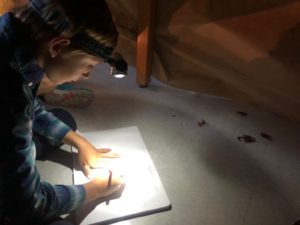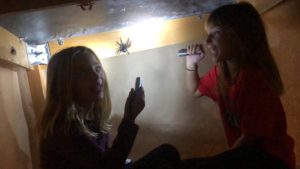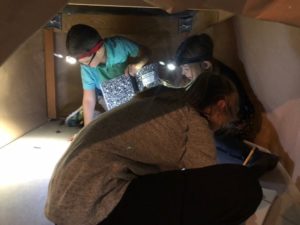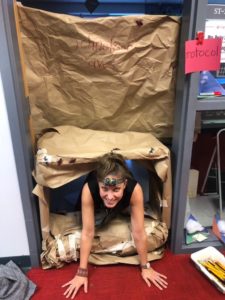I LOVE everything about this lesson!!! This is an absolutely fantastic example of how to live up to the Teach Like a Pirate motto, “Don’t just teach a lesson, create an EXPERIENCE!”
Becky Schnekser is an award-winning K-5 science teacher from Virginia who is an expert at connecting real field work to the science classroom. You can check out her amazing work on her expedition website RIGHT HERE.
Imagine the excitement that her students felt as they entered the cave system she created right in her classroom!!! I’ll let Becky tell you the story…enjoy!!
[divider style=’full’]
I had this crazy idea in the middle of class one day. My students are studying landforms of North America and participating in a postcard exchange with classes around the continent. They had also already assembled a wall-sized physical map of North America, and we were currently getting a little antsy as they worked on a slideshow about the schools with whom we exchanged postcards. What do you do?
Well, if you are me, you pull up some photos from college of you spelunking and engage them in a story of the time you were stuck in between a stalactite and a stalagmite. Classic teacher move, right? Tell a story and ambush them with content terminology. You don’t do that? You should totally try it; works every time.
As my students were on the edge of their seats, partly from the picture of me dangling upside down in a cave and partly because they wanted to know what happened next, it hit me. I need to take my students spelunking!
I know what you are thinking, they are third graders. Yes, and what is your point?
In that exact moment, I stopped telling my students the story. It was all part of the plan. I became stoic and serious and explained that on Friday, they would need lights. Headlamps, camping lanterns, flashlights, any light they could bring.
In my head, I had already planned the system of caves I would be creating in the room. In each cave, there would be hidden creatures for them to count and record. They would navigate through the cave system and complete a biodiversity survey. They would complete authentic field science. Sure, this would be a fabricated system of caves, but they would be doing real science, using field protocols and discovering a unique landform in North America. As luck would have it, as soon as I finished my story of surviving Trout Cave in West Virginia, their teacher returned to take them back to their general education classroom. I reminded them in a serious tone that they needed lights on Friday.
Then, I immediately jumped on Amazon to order bats, centipedes, roaches, beetles, tarantulas, and any other toy replica of cave creatures I possibly could. I went to the bulletin board rolls of paper down the hall stole an excessive amount of brown paper, chanting “Nothing to see here” in my head as I scurried to my classroom to hide my contraband.
When Friday rolled around, I wore my headlamp all day. My school, colleagues, and students should all be used to my antics by now, but alas they were taken aback when my hair was in an unusually high ponytail, and a headlamp dawned my forehead.
So many questions! Can’t a science teacher just walk around with field equipment on and not be questioned? Nope. I basically just denied anything was unusual all day, but then came lunchtime.
I teach grades K-5 science, so every class knew something was up while they already were in my laboratory while I donned a headlamp or now, the secret was definitely out as a trotted around the cafeteria. I made sure to visit the third-grade tables and ask them in a bit of an exaggerated tone, whether they remembered their lamps. It’s not difficult to excite students in the cafeteria on Friday, which is also ice cream day, but I sure did my best to up the ante. I am not sure my colleagues appreciated it, but it sure did set the scene for the afternoon in science.
I teach three sections of third-grade science, and this afternoon was spelunking day! You could hear my students approaching the laboratory trying to whisper to one another quietly, hold their lamps safely, and quickly arrive at the cave system. I used each lab table in my room as a cave. I covered 3 of the four sides with paper for the walls of the caves and stacked all of the chairs at the edge of the classroom. Two tables were placed together in an L-shape to create a large cave in the back of the room. Each cave stocked with its own collection of creatures for our scientists to track and record. I even covered the top half of the classroom doorway with paper announcing the beginning of “Schnekser Caves” and created a small entrance at the bottom that students needed to crawl through the enter the room. The lights were off; my headlamp was on.
As they tried to peer in the windows that were covered and dark, I explained to them that they were on an expedition to record the biodiversity of a newly discovered system of caves. They would need to navigate the caves safely, record the organisms they see and document the amount of each for all of the caves. They had to be careful not to touch any living thing because dangers such as stings, bites, and possible venomous creatures are unknown at this time.
You could feel their energy building as they gathered pencils, field notebooks, lights, and crawled into the cave system for the first time. I loved crawling into the caves with them, helping spot creatures, and listening to their squeals of excitement and surprise when they happened upon large tarantulas and bats hanging from the ceilings of caves or centipedes and cockroaches scaling the walls.
We took cave selfies and videos to document our expedition; they even barrel rolled out of the caves at the close of the journey to celebrate their successful adventure. In the next few days, we will create data tables and creative writing pieces to post on their blogs about their expedition.
The cross-curricular connections are endless, and each time I recall our first expedition together, new ideas pop up. My scientists had a fantastic time and are chomping at the bit to share it with others. We might even start a podcast!
[divider style=’full’]
WOW!!! Check out the pictures below to get a feel for how Becky transformed school into an unforgettable and powerful learning experience for students. Thanks so much to her for being willing to share her work!! Be sure to follow her on Twitter at @schnekser and tell us what you think using the #tlap and #ExpeditionSchnekser hashtags.
Make school amazing,
Dave
[divider style=’full’]










